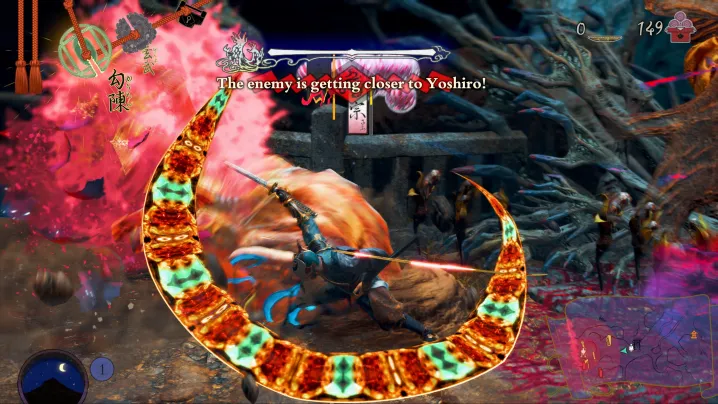The video game industry is in a period of contraction. Companies like Bungie are canceling games and laying off developers so they can home in and focus on one or two big titles. Why invest in smaller, riskier projects when making larger games in well-known franchises will yield greater returns? Capcom, on the other hand, is committed to doing both.
“I believe that the experience with a series or remake is important, but the experience of a new IP is also important,” Kunitsu-Gami: Path of the Goddess Director Shuichi Kawata told me in an email interview following the release of one of Capcom’s more experimental new games yet.
That’s a rare sentiment to hear from someone at a major video game developer and publisher behind AAA franchises. For the past several years, Capcom has continued to release games in popular series like Street Fighter, Resident Evil, and Dragon’s Dogma. Monster Hunter Wilds is poised to be one of the biggest games of 2025. Over that same period, it has also taken the time to create more experimental games like underwater Metroidvania Shinsekai: Into the Depths, multiplayer dinosaur shooter Exoprimal, and action-tower defense hybrid Kunitsu-Gami: Path of the Goddess.
Those games are just as entertaining as the latest Resident Evil or Street Fighter, giving Capcom one of the most actively diverse and inspiring game lineups outside of Nintendo. I interviewed Kawata, and producer Yoshiaki Hirabayashi. Discussing their work on a new IP exposed a key reason why Capcom is currently on a hot streak.
Making a new IP at Capcom
The idea for Kunitsu-Gami: Path of the Goddess came to Kawata around the time Apple Arcade exclusive Shinsekai: Into the Depths was completed. Kawata was a big fan of tower defense games and the strategy they require, and he wondered what it’d be like if a player had to take part in that action. The result is a game where players command units to defend a maiden from creatures called Seethe as she works to purify a corrupted Japanese mountain.
Kunitsu-Gami is a bold game with a unique gameplay genre mix, minimalistic but emotional storytelling, and mesmerizing visuals. While Kunitsu-Gami has drawn some comparisons to Capcom franchises like Okami and Onimusha, the game thrives because it isn’t pigeonholed to either of those series and is free to be as wild and creative as it wants.

Creating a new IP in that manner isn’t easy, but Kawata thinks it benefits the whole development team. “I believe that the challenge of creating a new IP with the entire team under limitations will lead to the growth of both the team and each individual, as each team member can experience the process of giving shape to ideas and creating products,” he explained.
Meanwhile, Producer Yoshiaki Hirabayashi’s concerns are more player-facing. Hirabayashi has experience working on original games like Kunitsu-Gami and well-worn franchises like Resident Evil. He thinks the biggest challenges with new IP are “getting users to recognize the titles” and “getting players to share the fun.”
To address this, Hirabayashi says that Capcom has to pay extra attention to the “order we deliver game elements and how we communicate with the community.” Kawata believes this is good for the growth of individual team members, who must work together and find answers to some of those tough questions in a “flexible and strong manner without getting caught up in our ideas.” That exposes an important thing all Capcom games do well: they keep the player in mind.
What players want
Even for something as esoteric as Kunitsu-Gami, once you go hands-on with the game, you’ll understand there’s something enchanting about it. I saw this in action at Summer Game Fest this year. Kunitsu-Gami was a game few people knew about heading into their Capcom appointment at this press event, but they raved about it once they played it.

Kunitsu-Gami is the kind of game that needs to be seen to be believed, which is why I think it was a smart move to get the game in Xbox Game Pass and into the hands of press and creators, who then raved about its innovative ideas. Ultimately, these Capcom devs said that keeping the “objective user perspective” in mind is the most important thing when working on a game, whether it’s a new IP or not.
“I think the most important things in game development are still the same: the importance of working together to create the game and the importance of thinking about the people who will be playing the game, regardless of whether it is a series, remake, or a new IP,” Hirabayashi says.
It doesn’t matter if the game is in a well-known franchise or potentially the start of a brand-new series. If the developers work together well and create something good that they will enjoy, then the results will be spectacular. That may seem simple, but an upfront approach toward game development and creating new IP seems to be the thing that makes Capcom games feel like Capcom games.

That’s something a lot of companies aren’t looking to do as they lay off developers and reorganize their teams to work on fewer projects that make more money. Whether players say it outright or not, there is a demand for new IP with innovative gameplay ideas from well-known studios. Capcom is willing to take bets on more experimental games like Kunitsu-Gami, while knowing that the challenges of making something very appealing to players at that scale are even more difficult as a known franchise isn’t attached. It is finding success while doing so too, as Kunitsu-Gami has already amassed 500,000 players less than a month after release.
We’ve potentially gotten what could be the start of a new Capcom series; if not, it’s still a well-executed novelty in the game library of Capcom’s renaissance. Kunitsu-Gami: Path of the Goddess is now available for PC, PlayStation 4, PS5, Xbox One, and Xbox Series X.
Services Marketplace – Listings, Bookings & Reviews